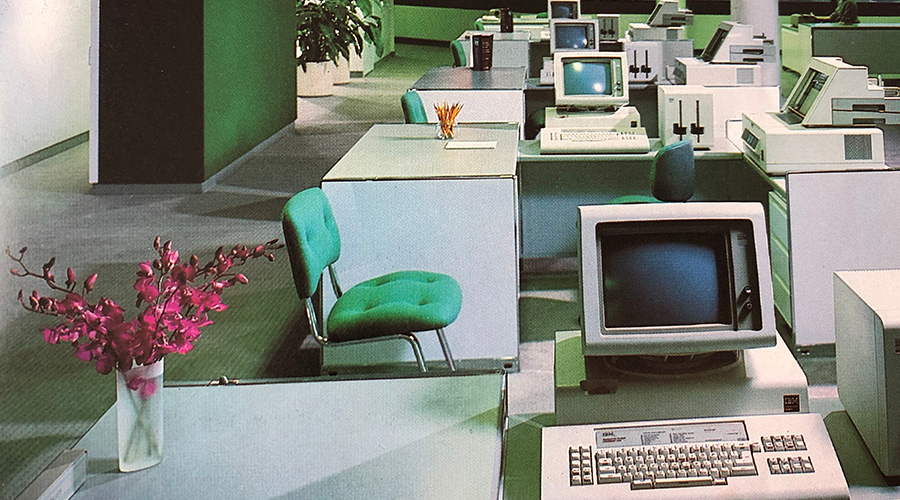Signs of Success
Putting facility signage in the right places is only part of the equation.
Sign-making systems help departments produce signs that are flexible and effective
Today, managers can specify flexible interior signage systems with changeable lettering that allow for frequent copy changes. Removable clear acrylic inserts with vinyl letters enable workers to easily update information, and they provide a straightforward, in-house option for flexible signage to meet the needs of today’s changing facilities.
Specifying and purchasing sign-making equipment can be a complicated process. Managers will need to understand the technical abilities of in-house staff. How well do they understand computers? With what operating systems are they most familiar?
Managers should consider purchasing sign-making equipment from a local supplier that could provide appropriate technical support. Managers who must buy based largely on price should carefully check out a prospective vendor’s customer support, training options, shipping policies and references.
Output devices are the most difficult components to evaluate because they are highly specialized. Managers should consider the following features at a minimum when evaluating output-device options:
Vinyl cutters. Consider reliability, size, perforated or non-perforated, and speed.
Printers. Printer technology is changing rapidly, so the questions relate to speed, reliability and size.
Sign-making Success
The biggest problem experienced by facilities tends to be the delivery time for a single sign order. Single orders usually take as long as a large order because the requirements for set-up time, color matching, and material are the same as those for a larger order. To reduce turnaround time, common size signs should be stockpiled and replenished in multiples as needed.
A very important, yet often overlooked, aspect of sign making is the quality of materials used — a factor that is just as important as the people entrusted with producing the signs. Location considerations often dictate the materials and type of manufacturing process used in producing signs. For example, areas prone to vandalism and abuse should have signage that can withstand tampering. Also, consider using mechanically-fastened signs in high-use areas.
Vinyl die-cut lettering is the easiest process to change quickly and inexpensively. Today, vinyl die-cut lettering machines are connected directly to the computer, on which the lettering and image can be manipulated and sent directly to the cutter. Also, many of these systems are affordable, which makes it easier for the manager to cost-justify the investment.
Three-dimensional (3-D) signs can help a facility stand out from the crowd. The distinctive and eye-catching look of 3-D letters will stand out from whatever type of surface to which they are applied, so they can be used for interior signs to draw people to a business or facility. Not only is this type if signage flexible and powerful in creating effective signs; it also is extremely durable.
Wayfinding
People either are helped or hindered when visiting a facility by the type of signage that is used. Visitors who find themselves in unfamiliar environments need to be able to determine their location in the complex. The layout of the facilities becomes important, and knowing their destination helps them get where they need to go.
Faulty sign design can cause navigation problems. Signs might lack visibility, or the lettering might lack legibility when viewed from a distance. Signs also might contain ambiguous, inaccurate or unfamiliar messages, or they might be obscured by obstructions or contain reflective surfaces that can hinder comprehension.
Wayfinding problems are not related to signs alone. Signs should not be a panacea for poor architectural and illogical space planning. Adding more signs throughout a facility typically can’t solve such problems.
Instead, problems such as these can be better solved by the involvement of maintenance early in the design process to ensure that interior spaces enable people to move quickly and easily from one area to another without confusion and to use signage logically and appropriately.
Regulations and Guidelines
The Americans with Disabilities Act access guidelines (ADAAG) include specifications for signage related to character proportions, character height, raised and Braille characters, pictorial symbol signs, color finish and contrast, mounting locations, and height. Signs mentioned in the regulations include the following:
Permanent signs. Signs that designate permanent rooms and spaces must have raised letters — at least 1/32 inch — and Grade 2 Braille. The guidelines define permanent rooms and spaces as areas whose function will not change once they are assigned. Characters must contrast with the sign background, and signs must be mounted at 60 inches from the floor to the midpoint of sign. Signs must be eggshell, matte or other non-glare finish; they must be mounted on a wall adjacent to the latch side of the door if possible; and they must be mounted so a person can approach within 3 inches but avoid door swing and protruding objects.
Signs that provide direction to or information about functional spaces. These sings include wall-mounted elements that provide direction to or information about the functional spaces of a building. These signs are not required to have tactile and Braille lettering, but they must comply with requirements for character proportion, height, finish and contrast.
Temporary signs. Building directories, menus and all other signs that provide temporary information about rooms and spaces need not comply with ADA guidelines, but signs must be made available with raised lettering and Grade 2 Braille if requested by a customer.
Overhead signs. Suspended or projected overhead signs need only meet clearance requirements. Minimum clearance is 80 inches between the sign bottom and the floor. These signs must comply with requirements for finish, character proportion, height and contrast. Letters need to be 3 inches tall or larger.
Locations to Watch
Areas such as restrooms, lunchrooms and conference rooms must be identified by signs that use internationally recognized visual symbols and that integrate tactile and Braille lettering. Entrances and exits that are not accessible must have compliant directional signage indicating the location of the nearest accessible entrance or exit.
Public telephones that must be accessible need signage that complies with applicable provisions, including identification with the international TDD symbol and/or international symbol for hearing loss.
Finally, accessible parking spaces for passenger loading zones must be designated by a sign showing the symbol of accessibility. Spaces that comply with van accessibility must have additional information on van accessibility mounted near the symbol of accessibility. The sign should be high enough to be seen over a van and cannot be obscured by a vehicle parked in the space.
Signs designating parking places for persons with disabilities must be visible from a driver’s seat if they are mounted high enough above the ground and located at the front of a parking space. These signs are not required to have tactile characters or Grade 2 Braille on them.
Signs generally are the first element that visitors notice about any facility, so they can be a powerful factor in establishing a good first impression.
Making Signage Work
To be effective, facility signage:
- must be highly visible to communicate effectively
- must enhance a facility’s décor, rather than compete with it
- must be large enough to be read from a reasonable distance
- should not have background clutter that might distract a viewer’s attention
- should be designed to enhance the distinction of individual letters
- should not become too familiar as part of the scenery, so their color, size or shape should be changed frequently
- should have the right type style and spacing to help viewers to read them easily and quickly
- should have simple type styles, especially for smaller lettering.
|
Related Topics:











